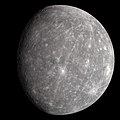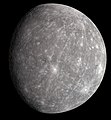Archivo:Mercury in true color.jpg

Tamaño de esta previsualización: 600 × 600 píxeles. Otras resoluciones: 240 × 240 píxeles · 480 × 480 píxeles · 768 × 768 píxeles · 1040 × 1040 píxeles.
Ver la imagen en su resolución original (1040 × 1040 píxeles; tamaño de archivo: 408 kB; tipo MIME: image/jpeg)
Historial del archivo
Haz clic sobre una fecha y hora para ver el archivo tal como apareció en ese momento.
| Fecha y hora | Miniatura | Dimensiones | Usuario | Comentario | |
|---|---|---|---|---|---|
| actual | 08:16 15 may 2023 |  | 1040 × 1040 (408 kB) | CactiStaccingCrane | Reverted to version as of 10:42, 24 July 2022 (UTC) |
| 08:01 15 may 2023 |  | 1024 × 1024 (837 kB) | CactiStaccingCrane | Manually merge the original monochrome image with the calibrated color image to eek out more resolution | |
| 10:42 24 jul 2022 |  | 1040 × 1040 (408 kB) | JCP-JohnCarlo | Make this planet image center | |
| 10:25 24 jul 2022 |  | 1040 × 1040 (710 kB) | JCP-JohnCarlo | Canvas image | |
| 09:00 3 nov 2019 |  | 960 × 1040 (865 kB) | Mirecki | User created page with UploadWizard |
Usos del archivo
Las siguientes páginas usan este archivo:
Uso global del archivo
Las wikis siguientes utilizan este archivo:
- Uso en af.wikipedia.org
- Uso en als.wikipedia.org
- Uso en ar.wikibooks.org
- Uso en as.wikipedia.org
- Uso en be-tarask.wikipedia.org
- Uso en beta.wikiversity.org
- Uso en bn.wikibooks.org
- Uso en bo.wikipedia.org
- Uso en br.wikipedia.org
- Uso en ceb.wikipedia.org
- Uso en ckb.wiktionary.org
- Uso en csb.wikipedia.org
- Uso en cv.wikipedia.org
- Uso en cy.wikipedia.org
- Uso en de.wikipedia.org
- Uso en dty.wikipedia.org
- Uso en dz.wikipedia.org
- Uso en eml.wikipedia.org
- Uso en en.wikipedia.org
- Mercury (planet)
- Terrestrial planet
- The Planets
- Timeline of discovery of Solar System planets and their moons
- List of Solar System objects by size
- List of gravitationally rounded objects of the Solar System
- User:Kwamikagami/sandbox
- NASA
- User:Kazkaskazkasako/Books/Physical sciences
- Talk:Mercury (planet)/Archive 3
- User:Nrco0e/Userboxes
- User:Applekle/sandbox
- Wikipedia:Userboxes/Location/Extraterrestrial
- Talk:The Planets/GA1
- User:Double sharp/Largest Solar System objects
- User:TomMasterReal
- User:Nrco0e/Userboxes/FavMercury
- User:KeroseneLover100/sandbox/sandbox
- Uso en en.wikibooks.org
- Uso en en.wiktionary.org
- Uso en eo.wikipedia.org
- Uso en fo.wikipedia.org
Ver más uso global de este archivo.


